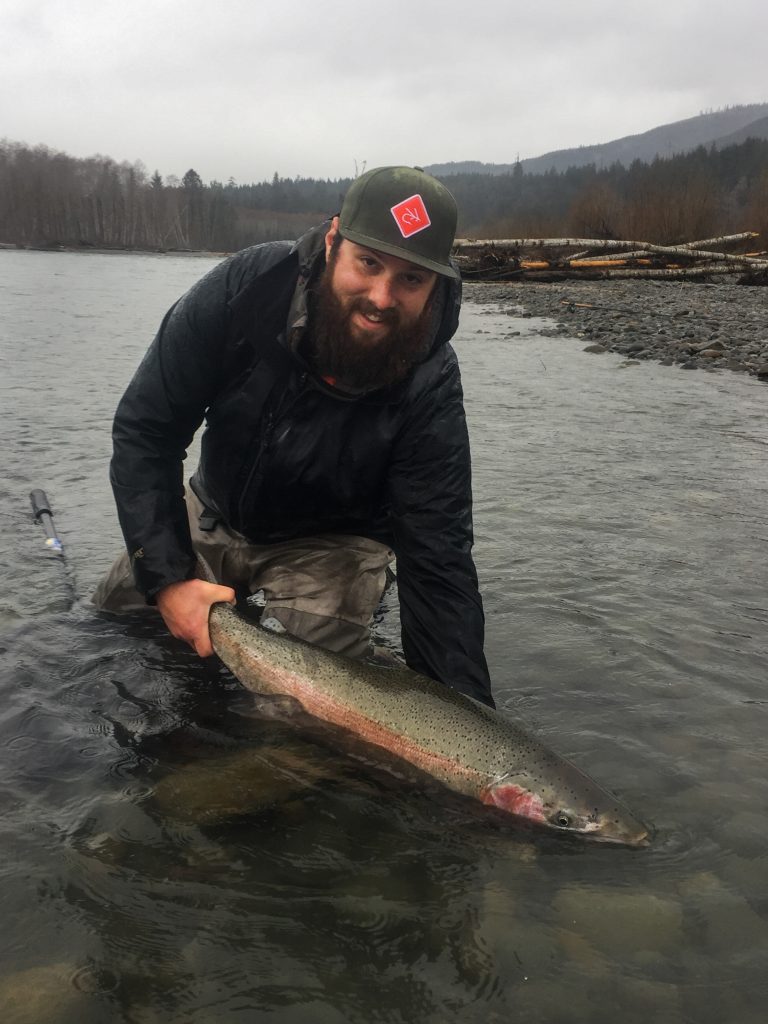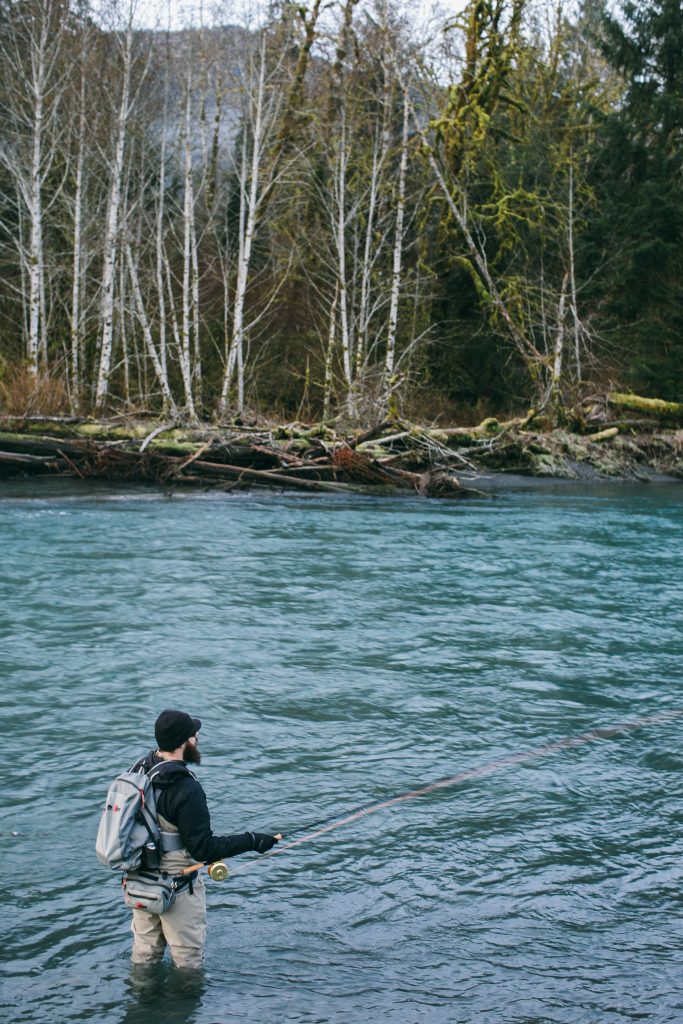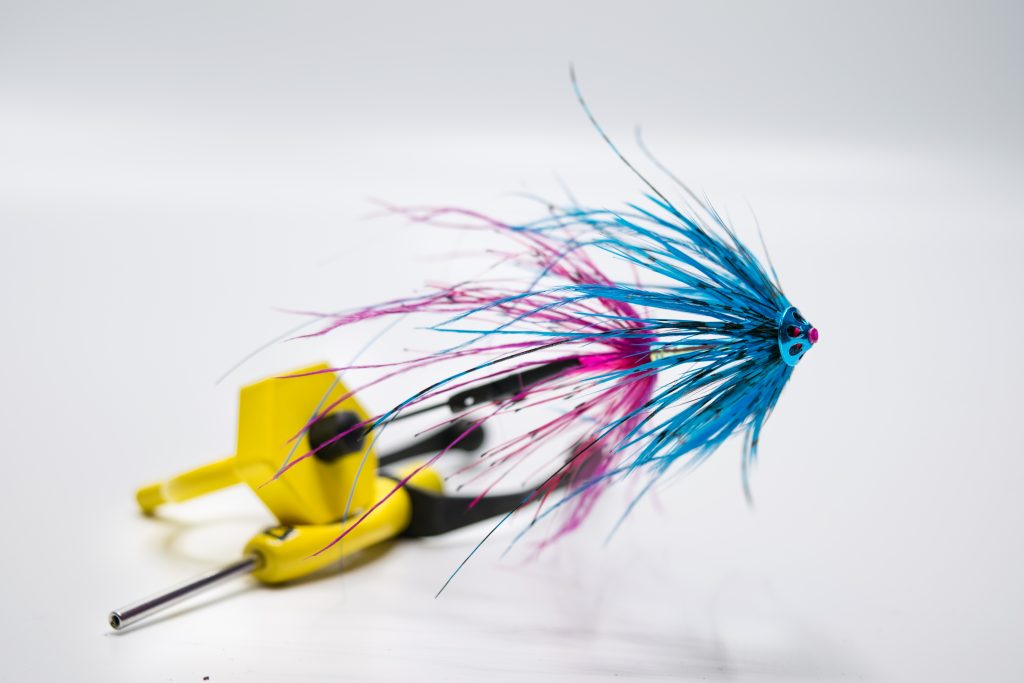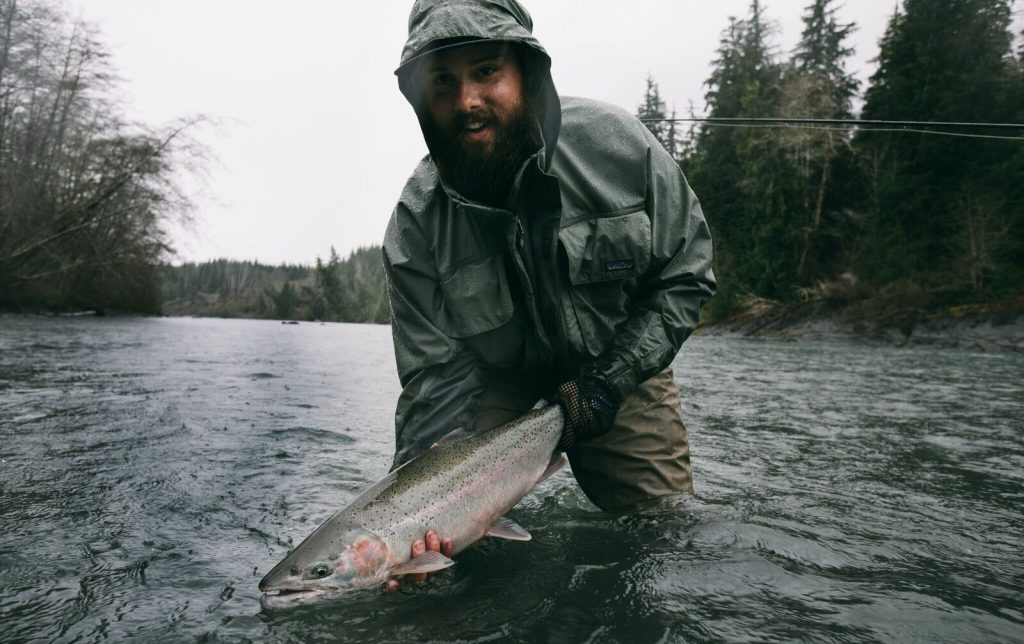Hell or High Water
Jeremiah Houle
Photos by Joey Houle
Winter in the Pacific Northwest brings to mind towering trees and lush undergrowth, moist from massive storms that ripen over the Pacific. Rivers swell to unimaginable volumes during the short days of winter and drop almost as quickly as they rise. Debris surrounding the river and sediment accumulated during the low flows of summer now get swiftly escorted downstream, turning the usually clear water into a cold, turbid current. Slabs of silver, veiled with a black back and translucent fins sneak out of the cold, dark ocean during these flows. Returning to fresh water after 2 or more years in the salt, these sexually mature Winter Steelhead ascend the raging torrents of steep coastal river systems, seeking the very water in which they themselves were spawned. Usually carrying a few more pounds than their summertime cousins, their size and power seem to perfectly compliment the challenging conditions and time of year in which they make this journey. The following is insight into how to most effectively target these impressive ocean going fish.

(A wild winter buck)
Timing
Since winter-time rivers usually run much bigger, colder and less clear than they do in the warm days of summer… I rely on my phone’s FishHead app, the USGS, and NOAA websites to constantly feed me information on the latest water flows and weather patterns. This is the homework needed to give yourself a fighting chance to encounter one of these mythical fish. While I obsess over these websites I am constantly searching for what I call “The Drop”. No, I am not talking about a Skrillex song; I’m talking about the sexy downward slope on a hydrograph that indicates a decreasing flow. When the relentless downpours finally slow, the forest’s dense vegetation and sponge-like soil absorb the recent precipitation, and the river’s flows (measured in cubic feet per second or C.F.S.) start drop to fish-able levels. Keep track of this. When is it too high or too low? Making a mental note, or even better, making an actual note can help plan future trips.

(A bright hen that was in a soft inside edge at the end of the swing)
Rods, Lines, and Flies
The lightweight Scandi line setup my clients and I use all summer and into the fall now get swapped for the short, heavy Skagit line that is necessary to deliver tungsten tips and three to five inch long winter flies. My light 6 weight Spey that is perfect for our Deschutes Summer Steelhead lacks the backbone and power to handle these dense, quick-sinking tips and thick winter fish. Out come my 7 and 8 weight two-handed rods preferably in the 11 to 13 foot range. They not only allow me to make long distance casts on wide rivers, but more importantly, they allow me to control the line, and in turn my fly, after those long casts. Shorter rods in the 11 foot range, matched with shorter Airflo Scout or O.P.S.T. heads excel in the wooded confines of a coastal river. The combination of shorter rod and line allows for shorter D-loops in those tight quarters, making casting easy, even in these daunting conditions. This is the time of year that gear gets pushed to the limits. Wading jackets have to keep anglers dry during the ever present rain; waders withstand long walks through thick, piercing vegetation; and wading boots try to stay locked in place while wading in heavy wintertime flows. The industry’s top gear companies gain their reputation putting their products against the challenging fishing conditions of the Great Pacific Northwest.
When the water starts getting big so do my flies. I like bigger, darker flies in off-colored water… allowing their silhouette to stand out against a lighter background. In the cold flows of winter I focus on getting my fly down quickly and keeping it down throughout the swing. This process starts with fly design, moves to the length of leader, followed by the size and density of the sink tip, and finally through to the Skagit head. Intruder style flies have revolutionized modern winter steelheading, allowing our flies to take on sizes unimaginable only a couple decades ago. The Intruder fly allows us to have big volume and presence in the water while limiting the amount of material being used, making for easier casting, excellent movement and a faster sink rate.

(Swinging flies in Sasquatch country)
To maximize the sink rate of my flies, I keep my leaders short, utilizing 3-5 feet of stout 15 lb. Maxima tippet. This also allows me to quickly land Wild Steelhead and minimize fatigue, returning them to the water quickly to continue their journey upriver. While fishing I never want to drag the bottom, however, I do want to ensure that, throughout my swing, I am deep enough to be near a lethargic Winter Steelhead. I carry several lengths of T-11, T-14 and T-17, usually 10 and 12 ½ ft lengths, as well as a couple of M.O.W. tips to ensure I can walk into a run and get my fly exactly where it needs to be. My starting quarterback sink tip is usually a 10 foot chunk of T-14 with a welded loop. Changing tips to adjust sink rate is quick and effortless, since the ends of a Spey head are looped as well. Be mindful that the designated sink rates on T- stuff are under “ideal conditions”. In faster water or with tension on the tip, you won’t be getting the sink rate that’s described on the package. Also, a floating Skagit will slow down the sink rate compared to a head that sinks, such as Airflo’s F.I.S.T. (Floating Intermediate Sink Three). A quick way to change the depth of your swing is to change the angle of your cast, allowing your fly and sink tip more time to dead drift before tension starts and your swing begins. If your usual cast is straight across the river and you start tapping bottom, adjust your angle a little more downstream. This adjustment allows for less sink before the tension builds and your fly starts to do its job. Taking steps before or after your cast is another easy way to add or remove depth to your swing. Steps taken after your cast allows a longer “dead drift” time, ensuring your tip digs deeper into the run, keeping that fly down. As you work down a run, you should constantly evaluate your next cast to make sure you are giving yourself the best shot at a grab.
For our smaller coastal rivers, the floating Skagit Compact G2 lines from Airflo or Rio’s Skagit Max are perfect. These lines allow me to mend and adjust for the pockets and seams that spring up within a run. When I want to get my sink tip down and keep it down, my choice is the F.I.S.T. from Airflo. This line breaks through the tension on the water’s surface, keeping your fly deeper throughout the entire swing. It also feels like my fly swings slower as that sinking portion cuts through the faster currents on top, dropping into the good stuff below. I’m not sure if this is true or just a weird mind trick, but either way, I like it. I am OK with a little speed on my fly during my swing. I don’t want my fly to park mid swing, because I’ve mended 50 times like a mad man. I’m a firm believer that Steelhead are curious creatures and that a moving fly piques their interest. I also like to show those fish how much work I put into tying my fly, presenting it to them broadside or at least a quartering-away view.

One reason I love steelheading so much, is not having to match the hatch. Our flies might have some resemblance to their ocean foods, like squid or prawns, but we aren’t trying to mimic anything in particular. Less is more when tying these flies and I strive for the materials in my flies to complement one another. For example, I use stiff materials to hold up softer materials, allowing them to appear much bigger without using more material. Thin bodies and less material help these flies sink quicker; while ostrich, rhea, rabbit and marabou give tons of movement and a full bodied appearance. It also goes without saying that a small, trailer style hook does a lot less damage than larger ones. Pinching down the barb also helps when removing the hook from a fish, or an angler in the event of an errant cast.

The best part of swinging flies in the Great Pacific Northwest is definitely the view. Not staring at a fluorescent orange bubble all day or trying to spot and keep track of a tiny dry fly… make your cast, make your mend and enjoy your surroundings. Two handed rods, Skagit lines, and Intruder style flies have changed Winter Steelhead fly-fishing forever. We can now cast farther, get deeper, and fish bigger flies. What once was difficult is now feasible in the hands of even the novice Steelheader.

(An acrobatic buck during an unforgettable rain storm)
Reading the Water
One thing I see over and over again, is people fishing unproductive water. Most of us don’t get as much time on the water as we would like, maximize your chances of connecting to a steelhead by making sure your fly is in fishy water. Try taking a picture or writing down some details when you hook a steelhead. Over time you will start to see a pattern and automatically gravitate towards good water. For most steelhead runs I like water that is 2-6 feet deep and walking speed. For example, if a leaf were to drop in the water you should be able to keep up with it at a walking speed. The depth is a variable, I’ve hooked steelhead at the top of a run in what seems like a foot of water, and in water much deeper, but that 2-6 feet of water will hold most of your fish. Sticking to this outline will prevent you from wasting valuable time on water that’s moving too quickly, too slowly, might be too shallow, or too deep.
Now for Steelhead Nirvana… find a run with some boulders strewn throughout. Boulders create soft spots for steelhead to rest as they make their upstream journey. Seams are also something to pay attention to, but look at them differently than you would when you trout fish. Remember, we are swinging flies across the river, not dead-drifting flies into their face. The seam might be a 20 foot section of your swing, not a lane you drift down. Here is the most important part of this whole equation: Have confidence! Confidence in your swing, the run you’re fishing and your fly. If you lose faith in any of these, change that factor and you’ll be amazed at how good you will feel.

(Doug French showing off a perfect Keep Em Wet Shot on a very wet morning)
If you swing it, they will grab… eventually. If you’re in the right spots (and fishing well) it will happen. We all hear about “unicorns”, “ghosts”, and the “fish of a thousand casts” and when it comes to swinging flies for steelhead, these are all true to a certain extent. If you eliminate junk water and fish great holding runs all day, your chances of hooking Steelhead greatly increases. Try not to chase the “hot” river, because by the time you get there it might not be so hot. I am more concerned with water levels than someone’s report. Find a river nearby or just one you love to be in and stick with it, learn its runs, find out at what flows it fishes best, and remember where you have hooked fish in the past. This, over a winter season, is your best bet to get into more fish. I am not saying, “Don’t explore new water”, but knowing your water is a good idea when you want to make the most of your time. Steelheading is not easy and it shouldn’t be. The challenge helps you appreciate everything about these fish… the random spotting on their back… the faint pink blush on the cheeks of a beautiful hen… or the deep red stripe of a buck who has spent weeks battling his way through the roughest of water to pass his genes to the next generation. I still have had more trips than I would like to admit that end up in “naw, but I got a grab though”, and I’m OK with that.
True Steelheaders are seduced by the aggressive grabs, the elusiveness of these fish, and how difficult it can be to hook one. A fish that inspires so much passion and devotion deserves the same passion and devotion in return. Remember that in almost every West Coast River, Steelhead are either threatened or endangered. Although catching one of these amazing creatures does briefly interfere with their migration upstream, there are a few things you can do to ensure the healthy return of each one to the water. First off, use strong tippet. If a fish is grabbing your 5 inch long Intruder they don’t care about 4x or 15 lb Maxima. With stronger tippet you can bring these fish quickly to hand, and then get them back on their way, eliminating unnecessary fatigue. Landing fish in deeper water is crucial, and often overlooked. Beaching fish or dragging them into shallow water leaves them vulnerable to bonking themselves. It just takes one head shake to slam their head against a rock and cause severe damage. Also, those pictures of fish laying on the ground are horrible. No one wants to see your fish covered in dirt, laying next to your rod. If you’re fishing with a buddy or are around a boat, I always have a large, soft rubber net to land fish. Leave those old school knotted nets at home, or better yet, cut them up and recycle them. That style of net removes the protective slime coating and greatly increases the chance of causing damage to the fish. With modern rubber or soft nets you can land them quicker and in deeper water… minimizing handling time. Steelhead are magnificent creatures. I love getting a quick picture with them, a small memento that is truly worth a thousand words. We can even take pictures a certain way to minimize the harm on these fish. If you’re fishing alone, get a cool in- the-water body shot. With the proper angle the picture looks great and you’re not harming the fish for the sake of a hash tag. If fishing with someone, keep the fish completely in the water until your buddy with the camera is ready to go. Lens cap off, power on, in focus and everything is perfect. Do a 3-2-1 countdown and with a quick lift ensuring that the head is still underwater, the picture is taken and the fish is returned immediately to the water. The water flowing around the fish looks great and brings a little action and life to the picture.
These fish epitomize the beauty of the Pacific Northwest. It is my hope that you learn to appreciate them as much I do. With most populations in the Pacific Northwest a mere 1-2% of their historic numbers … Steelhead need more advocates now than ever.
Have confidence in your fly.
Have confidence in your swing.
Pay your dues and hold on tight.







